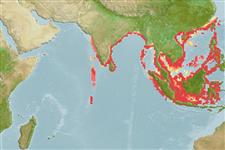Environment: milieu / climate zone / depth range / distribution range
Ecologia
marinhas; estuarina; anfídromo (Ref. 51243); intervalo de profundidade 0 - 50 m (Ref. 188). Tropical; 29°N - 8°S, 72°E - 124°E (Ref. 188)
Indo-Pacific: Indian Ocean (Malabar coast to Calcutta), Java Sea (off Java), Arafura Sea (Ref. 9819), South China Sea (Singapore, Gulf of Thailand), East China Sea (north to Taiwan Island).
Tamanho / Peso / Idade
Maturity: Lm ? range ? - ? cm
Max length : 22.0 cm SL macho/indeterminado; (Ref. 108866)
Espinhos dorsais (total): 0; Espinhos anais 0; Raios anais : 35 - 48. Belly with usually 17 to 21 + 8 or 9, total 25 to 30 scutes. Eye large, lower jaw projecting. Dorsal fin origin a little before midpoint of body; anal fin origin under hind part of dorsal fin base. Vertical striae on scales traversing whole scale or overlapping across center of scale. Swim bladder with two tubes passing back in the muscles on either side of haemal spines.
Occurs in coastal waters but enters estuaries and presumably able to tolerate lowered salinities. Feeds on plankton (probably small crustaceans, etc.).
Ciclo de vida ou comportamento de acasalamento
Maturidade | Reprodução | Desova | Ovos | Fecundidade | Larvas
Whitehead, P.J.P., 1985. FAO Species Catalogue. Vol. 7. Clupeoid fishes of the world (suborder Clupeoidei). An annotated and illustrated catalogue of the herrings, sardines, pilchards, sprats, shads, anchovies and wolf-herrings. FAO Fish. Synop. 125(7/1):1-303. Rome: FAO. (Ref. 188)
Status na Lista Vermelha da UICN (Ref. 130435)
Ameaça para os humanos
Harmless
Uso pelos humanos
Pescarias: pouco comercial
Mais informação
Nomes comunsSinônimosMetabolismoPredadoresEcotoxicologiaReproduçãoMaturidadeDesovaAgregação de desovaFecundidadeOvosDesenvolvimento dos ovos
ReferênciasAquaculturaPerfil para aquaculturaEstirpesGenéticaElectrophoresesHereditariedadeDoençasProcessamentoNutrientsConversão de massa
ColaboradoresFotosStamps, Coins Misc.SonsCiguateraVelocidadeTipo de nataçãoÁrea branquialOtólitosCérebrosVisão
Ferramentas
Relatórios especiais
Baixar XML
Fontes da internet
Estimates based on models
Preferred temperature (Ref.
123201): 25 - 29.2, mean 28.6 °C (based on 752 cells).
Índice de diversidade filogenética (Ref.
82804): PD
50 = 0.5000 [Uniqueness, from 0.5 = low to 2.0 = high].
Bayesian length-weight: a=0.00851 (0.00525 - 0.01379), b=3.05 (2.91 - 3.19), in cm total length, based on LWR estimates for this species & Genus-body shape (Ref.
93245).
Nível Trófico (Ref.
69278): 3.5 ±0.47 se; based on food items.
Resiliência (Ref.
120179): Elevada, tempo mínimo de duplicação da população menor que 15 meses (Preliminary K or Fecundity.).
Fishing Vulnerability (Ref.
59153): Low vulnerability (17 of 100).
Nutrients (Ref.
124155): Calcium = 183 [103, 368] mg/100g; Iron = 1.53 [0.91, 2.45] mg/100g; Protein = 19.3 [17.9, 20.7] %; Omega3 = 0.422 [0.221, 0.802] g/100g; Selenium = 36.8 [19.1, 76.5] μg/100g; VitaminA = 23.3 [9.0, 55.8] μg/100g; Zinc = 1.75 [1.27, 2.40] mg/100g (wet weight);
